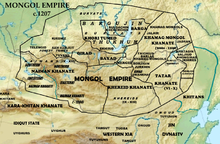Naimanen
Die Naimanen (auch: Naiman-Türken[1][2] oder Naiman-Mongolen[3] (mongolisch Найман/Naiman „acht“)) war der mongolische Name einer mittelalterlichen Volksgruppe, welche in der Steppe Zentralasiens lebte. Sie führten diplomatische Beziehungen mit den Kara Kitai und waren ihnen zeitweise untertan. Die Naimanen werden am häufigsten als Turkvolk eingestuft[4][5][6][7], einige Quellen klassifizieren sie aber auch als Mongolen.[7] Wie die Keraiten waren viele von ihnen nestorianische Christen.
Mehr als 400.000 der Einwohner Kasachstans stammen von den Naimanen ab (so zum Beispiel die Mittlere Horde), insbesondere im Osten des Landes. Ein Teil der Naimanen vermischte sich mit den Kirgisen und Usbeken.
In Afghanistan stammt eine kleine Gruppe der Hazara ebenfalls von den Naimanen ab. Sie leben als Sunniten in einem Dorf namens Naiman.
Religion
Zum Zeitpunkt, als die Naimanen von Dschingis Khan erobert wurden, waren die meisten von ihnen nestorianische Christen. Sie gehörten zur zweiten Welle von Christen, welche mit Kublai Khan in China einwanderten.[8]
Siehe auch
Quellen
- ↑ Steven Runciman: A History of the Crusades. Band 3: The Kingdom of Acre and the Later Crusades. Cambridge University Press, Cambridge 1999, ISBN 0-521-06163-6, S. 240.
- ↑ Edward Gibbon: The History of the Decline and Fall of the Roman Empire. Band 7. Edited in seven Volumes with Introduction, Notes, Appendices, and Index by John B. Bury. Methuen, London 1920, S. 2, 4.
- ↑ The Library of Congress: Country Studies. Mongolia. Early Wars in China. Juni 1989, (online (Memento vom 23. September 2008 im Internet Archive)).
- ↑ Paul Ratchnevsky: Genghis Khan. His Life and Legacy. Translated and edited by Thomas Nivison Haining. Blackwell, Oxford u. a. 1992, ISBN 0-631-16785-4, S. 1–4.
- ↑ Hans Robert Roemer, Wolfgang-Ekkehard Scharlipp (Hrsg.): History of the Turkic peoples in the Pre-Islamic Period (= Philologiae Turcicae Fundamenta. 3 = Philologiae et Historiae Turcicae Fundamenta. 1). Schwarz, Berlin 2000, ISBN 3-87997-283-4, S. 219, 224–225.
- ↑ William Darrach Halsey (Hrsg.): Collier’s Encyclopedia. With Bibliography and Index. Band 16. Crowell-Collier u. a., New York u. a. 1984.
- ↑ a b Marie A. Czaplicka: The Turks of Central Asia in History and at the Present Day. An Ethnological Inquiry into the Pan-Turanian Problem and Bibliographical Material relating to Early Turks and the present Turks of Central Asia. Clarendon Press, Oxford 1918.
- ↑ Columba Cary-Elwes: China and the Cross. A Survey of Missionary History. P. J. Kenedy and Sons, New York NY 1956, S. 37.
Auf dieser Seite verwendete Medien
Autor/Urheber: Khiruge, Lizenz: CC BY-SA 4.0
Map of the homelands of the tribes of the Mongol Empire in 1207 and preceding polities. Based on File:Asia laea relief location map.jpg.

